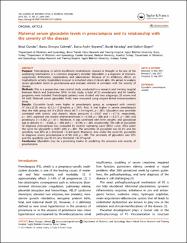| dc.contributor.author | Dündar, Betül | |
| dc.contributor.author | Dinçgez Çakmak, Burcu | |
| dc.contributor.author | Aydın Boyama, Burcu | |
| dc.contributor.author | Karadağ, Burak | |
| dc.contributor.author | Özgen, Gülten | |
| dc.date.accessioned | 10.07.201910:49:13 | |
| dc.date.accessioned | 2019-07-10T19:58:31Z | |
| dc.date.available | 10.07.201910:49:13 | |
| dc.date.available | 2019-07-10T19:58:31Z | |
| dc.date.issued | 2018 | en_US |
| dc.identifier.citation | Dündar, B., Dinçgez Çakmak, B., Aydın Boyama, B., Karadağ, B. ve Özgen, G. (2018). Maternal serum glycodelin levels in preeclampsia and its relationship with the severity of the disease. Journal of Maternal-Fetal & Neonatal Medicine, 31(21), 2884-2892. https://dx.doi.org/10.1080/14767058.2017.1359530 | en_US |
| dc.identifier.issn | 1476-7058 | |
| dc.identifier.issn | 1476-4954 | |
| dc.identifier.uri | https://dx.doi.org/10.1080/14767058.2017.1359530 | |
| dc.identifier.uri | https://hdl.handle.net/20.500.12511/3184 | |
| dc.description | WOS: 000440610300013 | en_US |
| dc.description | PubMed ID: 28738719 | en_US |
| dc.description.abstract | Purpose: Preeclampsia, in which insufficient trophoblastic invasion is thought to be one of the underlying mechanisms, is a common pregnancy disorder. Glycodelin is a regulator of immunosuppression, fertilization, implantation, and placentation. Because of its inhibitory effects on trophoblastic activity, trophoblast invasion is disturbed when its levels alter. We aimed to analyze serum glycodelin levels in preeclampsia and evaluate whether it correlates with the severity of disease.Methods: This is a prospective case-control study conducted in a research and training hospital between March and September 2016. In this study, a total of 55 preeclamptic and 65 healthy pregnants were included. Preeclamptic patients were divided into two subgroups: 25 severe and 30 mild. Maternal serum glycodelin levels were measured using enzyme-linked immunosorbent assay.Results: Glycodelin levels were higher in preeclamptic group as compared with controls (71.3822.78 versus 42.32 +/- 12.28ng/ml, p<.001). Also, it was higher in severe preeclampsia than the mild group (84.19 +/- 24.58 versus 60.71 +/- 14.4ng/ml, p<.001). Glycodelin was positively correlated with systolic and diastolic blood pressures (r=0.637 and r=0.714, respectively, p<.001), aspartate and alanine aminotransferases (r=0.369, p=.006 and r=0.377, p=.005) and proteinuria (r=0.342, p=.011). Moreover, it was correlated with birth weights and gestational age at delivery (r=-0.386, p=.004 and r=-0.394, p=.003, respectively). The role of glycodelin to diagnose preeclampsia was evaluated by receiver operating curve (ROC) curve. Area under the curve for glycodelin is 0.897 with p<.001. The sensitivity of glycodelin was 83.6% and the specificity was 80% at a threshold>53.64ng/ml. Moreover, area under the curve for glycodelin to diagnose severe preeclampsia is 0.788 with p<.001. The sensitivity of glycodelin was 59% and the specificity was 93.3% at a threshold >83.97ng/ml.Conclusion: Glycodelin may be a promising marker in predicting the presence and severity of preeclampsia. | en_US |
| dc.language.iso | eng | en_US |
| dc.publisher | Taylor & Francis Ltd | en_US |
| dc.rights | info:eu-repo/semantics/openAccess | en_US |
| dc.subject | Glycodelin | en_US |
| dc.subject | Preeclampsia | en_US |
| dc.subject | Severity | en_US |
| dc.subject | Maternal Serum | en_US |
| dc.title | Maternal serum glycodelin levels in preeclampsia and its relationship with the severity of the disease | en_US |
| dc.type | article | en_US |
| dc.relation.ispartof | Journal of Maternal-Fetal & Neonatal Medicine | en_US |
| dc.department | İstanbul Medipol Üniversitesi, Tıp Fakültesi, Cerrahi Tıp Bilimleri Bölümü, Kadın Hastalıkları ve Doğum Ana Bilim Dalı | en_US |
| dc.identifier.volume | 31 | en_US |
| dc.identifier.issue | 21 | en_US |
| dc.identifier.startpage | 2884 | en_US |
| dc.identifier.endpage | 2892 | en_US |
| dc.relation.publicationcategory | Makale - Uluslararası Hakemli Dergi - Kurum Öğretim Elemanı | en_US |
| dc.identifier.doi | 10.1080/14767058.2017.1359530 | en_US |
| dc.identifier.wosquality | Q3 | en_US |
| dc.identifier.scopusquality | Q2 | en_US |


















